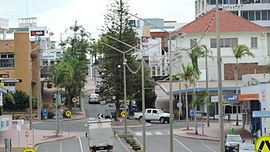Population 1,529 (2011) State electorate(s) Gladstone Postal code 4680 Lga Gladstone Region | Postcode(s) 4680 Gladstone Central Barney Point Federal division Division of Flynn | |
 | ||
Gladstone Central is a suburb in the Gladstone Region, Queensland, Australia. It is the historic centre and central business district of the city of Gladstone and the seat of the Gladstone Regional Council. In the 2011 census, Gladstone Central had a population of 1,529 people.
Contents
Geography
Gladstone Central is bounded by Auckland Inlet on the north, Auckland Creek and Side Street on the west, the railway line on the east and a combination of Scenery Street and Tank Street on the south. The main business and shopping street is Goondoon Street which runs over a hill, its apex being at the intersection with Roseberry Street.
History
The Gladstone Post Office opened on 1 July 1854.
Gladstone State School opened on 1 April 1861 and was later renamed Gladstone Central State School.
Amenities
The Gladstone City Library is at 39 Goondoon Street; it is operated by the Gladstone Regional Council.
The Gladstone Entertainment & Convention Centre is at 58 Goondoon Street; it is operated by the Gladstone Regional Council. It features an auditorium seating 674 people, a flat floor space which can accommodate 1,500 people standing, an outdoor 600 square metres (6,500 sq ft) marquee on a hard stand, and a number of meeting rooms.
There is a Gladstone Regional Council administration centre at 101 Goondoon Street.
St Andrew's Presbyterian Church
St Andrew's Presbyterian Church is located at 149 Goondoon Street on the corner of Bramston Street. This is the second church built on this site.
A Presbyterian minister, Alexander Proudfoot, arrived in Gladstone in September 1865; he was the first religious leader in Gladstone. However, for two years, there were not sufficient funds to build a church until a generous donation of £200 was received from a local settler. The church was designed by Mr Ramsay, the town surveyor in Maryborough. The foundation stone of the first church was laid on 30 October 1867 by Mrs Proudfoot, wife of Rev. Proudfoot. The brick Gothic church to accommodate 250 worshippers were built by local contractors, Smith, Hay and Day, at a cost of £457; it could accommodate 250 worshippers. In April 1870 W. S. Robertson donated a marble font which he designed and executed using marble from his own quarry on the Calliope River. This was the first church to be built in Gladstone.
Still the only religious leader in Gladstone, Alexander Proudfoot died on 11 April 1873 aged 42 years in Rockhampton (where he had been taken for medical treatment as Gladstone had no doctor). His widow established a ladies' school in Rockhampton 4 months later. The Rev. A. A. Laing took charge of the parish from 8 February 1874. Rev. Laing was replaced by Rev. J. Blaine in June 1875.
The church was destroyed by a cyclone on 2 March 1949. On 11 September 1955, the Governor of Queensland, Sir John Lavarack laid the foundation stone for the new St Andrew's church. The original foundation stone, font and pulpit were recovered from the demolished church and were incorporated into the new church.
Our Lady Star of the Sea Catholic Church
Our Lady Star of the Sea Catholic church is located on the south-west corner of Goondoon and Herbert Streets. It has an adjoining school. It is the third Catholic church to be built in Gladstone.
The first Catholic church in Gladstone was St Mary's Church in Auckland Street. It was opened on 1 March 1874 by the Rev. Dean Murlay, but did not have a resident priest until 1885. However, in 1902, the land was resumed to build a new railway line between Gladstone and Rockhampton.
A site of 2 acres (0.81 ha) bounded by Goondoon Street, Herbert Street and Glenlyon Road was purchased with a plan to build a precinct to eventually comprise a church, a school, a convent and a monastery. The monastery would serve as both a presbytery and a sanitorium for missionaries working in the Pacific islands. The architects for the new church and school were Eaton and Bates; the builders were Robinson & Freeman. The new church was opened on 19 January 1902 by the Bishop of Rockhampton, Joseph Higgins.
A larger church was required to meet the growing parish, leaving to the current church being built in 1924 at a cost of £2700. The foundation stone was laid on 13 April 1924 by the Bishop of Rockhampton, Rev. Joseph Sheil. It was officially opened on 16 November 1924. The second church continued to be used as part of the school.
In the cyclone of 2 March 1949, the convent and school were destroyed but the church survived.
Education
Gladstone Central State School is a government co-educational primary (P-7) school located at 74 Auckland Street. In 2013, the school had 226 students and 13 teachers (12 equivalent full-time).
